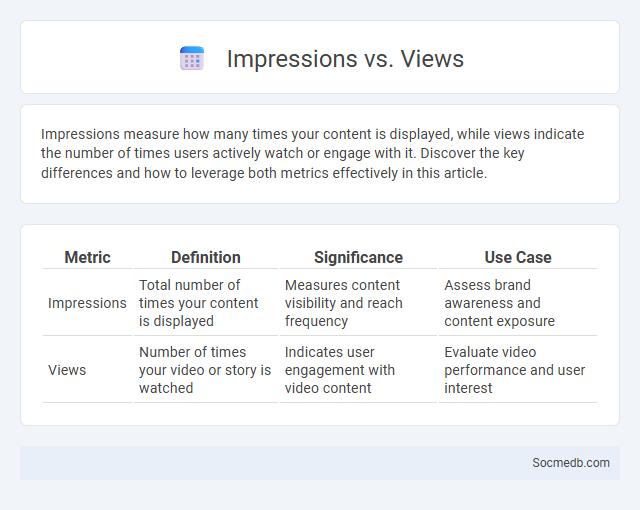
Photo illustration: Impressions vs Views
Impressions measure how many times your content is displayed, while views indicate the number of times users actively watch or engage with it. Discover the key differences and how to leverage both metrics effectively in this article.
Table of Comparison
| Metric | Definition | Significance | Use Case |
|---|---|---|---|
| Impressions | Total number of times your content is displayed | Measures content visibility and reach frequency | Assess brand awareness and content exposure |
| Views | Number of times your video or story is watched | Indicates user engagement with video content | Evaluate video performance and user interest |
Understanding Impressions: Definition and Importance
Impressions represent the total number of times your social media content is displayed to users, serving as a crucial metric to gauge visibility and reach. Understanding impressions helps you evaluate how often your posts are exposed, which directly influences brand awareness and audience engagement. By analyzing impressions, you can optimize your content strategy to enhance your social media impact and maximize user interaction.
What Are Views? Key Differences from Impressions
Views on social media refer to the number of times a video or content has been watched or engaged with by users, indicating active interaction. Impressions represent the total count of how often a post or ad appears on users' screens, regardless of engagement or visibility duration. Unlike impressions, views provide a more accurate measure of user interest and content effectiveness by tracking actual consumption rather than mere exposure.
Impressions vs Views: Semantic Distinctions Explained
Impressions represent the total number of times social media content is displayed, regardless of user interaction, while views specifically count when users actively watch or engage with video content. Impressions measure exposure and reach, indicating potential audience size, whereas views reflect actual consumption and user interest. Understanding the semantic distinction between impressions and views is essential for accurately evaluating the effectiveness of social media campaigns and optimizing content strategy.
How Impressions Are Measured Across Platforms
Impressions on social media platforms represent the total number of times a post or ad is displayed, regardless of clicks or engagement. Each platform uses unique algorithms and tracking pixels to count impressions, with Facebook and Instagram measuring based on content visibility on users' screens, while Twitter counts both organic and promoted tweet views. Accurate impression measurement helps marketers evaluate reach and optimize content strategy by analyzing platform-specific metrics such as CPM (cost per thousand impressions) and frequency.
The Role of Views in Audience Engagement
Views serve as a critical metric for measuring audience engagement on social media platforms, directly influencing content visibility and user interaction. High view counts signal content relevance and popularity, encouraging further sharing and comments, which enhance the algorithmic ranking. Brands and creators leverage these insights to optimize posts, targeting specific demographics for improved reach and engagement rates.
Common Misconceptions: Impressions vs Views
Impressions count the total number of times your content is displayed, regardless of whether it was actively watched or engaged with, while views specifically measure the number of times your content was actually watched or interacted with by users. Many confuse impressions as an indicator of content success, but views provide a more accurate reflection of audience engagement and interest. Understanding the difference helps you better evaluate your social media performance and optimize your content strategy.
Impressions in Digital Marketing Metrics
Impressions in digital marketing measure the number of times your content is displayed on a user's screen, serving as a key indicator of reach and visibility. High impression counts can signal strong brand awareness and increased potential audience engagement. Tracking impressions helps you evaluate campaign performance and optimize content placement strategies for maximum impact.
Why Tracking Views Matters for Content Strategy
Tracking views on social media provides critical insights into audience engagement and content performance, enabling content creators to identify which posts resonate most effectively. Analyzing view metrics helps optimize posting times and formats, enhancing reach and interaction rates. Understanding these patterns drives data-informed decisions that boost overall content strategy effectiveness and brand visibility.
Practical Examples: Impressions and Views in Action
Impressions and views measure different types of engagement on social media; impressions count how many times your content is displayed, while views track the actual number of times users watch or interact with it. For example, a video might have 10,000 impressions but only 3,000 views, indicating that while many saw the post, fewer engaged actively. Understanding these metrics helps you optimize your content strategy by focusing on formats and topics that drive genuine viewer participation.
Choosing the Right Metric: Impressions or Views?
Choosing the right metric between impressions and views depends on Your campaign goals: impressions measure how many times your content is displayed, highlighting brand visibility, while views capture active engagement by indicating how many people watched your video or interacted with your post. Impressions are ideal for awareness-focused campaigns aiming for broad reach, whereas views are better suited for assessing content effectiveness and audience interest. Understanding these distinctions helps optimize your social media strategy for maximum impact.
 socmedb.com
socmedb.com